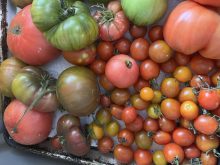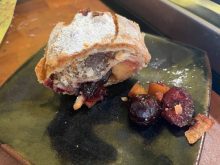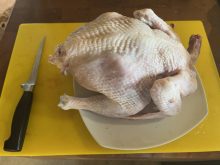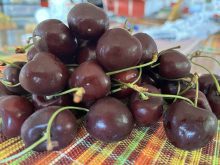It’s hard to ignore the pejorative meanings of the word “egg” lurking under the straw scattered about the henhouse. So let’s just call out a few to clear the air: “egghead” is slang for a smart person; “egg on your face” means you’ve messed up and are embarrassed; “egging someone on” is to encourage foolish behaviour. But there’s this: to a believer, the egg is a symbol of rebirth in many faiths. There are more, but that’s enough. We’ve established that the word is loaded.
Read Also

Gentle treatments for pain in the neck
Heading toward year-end, people unknowingly tense up against the cold and busyness, causing neck pain that can often be treated with appropriate support and gentle mobility, athletic therapist Kathlyn Hossack says.
The egg’s reputation was loaded in the negative cooking column for years as well, when it was considered unhealthy because of fat and cholesterol content, despite high protein and vitamin content. But opinions change as research evolves. According to the Mayo Clinic, a leading academic medical centre in Minnesota, the cholesterol contained in an egg doesn’t seem to negatively affect heart health. The clinic’s current consumption recommendation is up to seven eggs per week for healthy adults. So I eat eggs joyfully.
When I asked my mom about her favourite egg dish, she immediately said, “Omelet.” Dave, my husband, said, “Sunny side up.” But then he elaborated: “With crisp bacon, real hash browns — you know, the grated ones — and sourdough or rye toast.” Those two mostly eat eggs in the morning, but back in my years as a working chef, scrambled eggs or an omelet was my go-to meal when I got home late at night following a catering gig or an evening shift at my restaurant, or after I’d taught a class.
Dave has offered a few times to make scrambled eggs for me, but the texture of eggs is a personal thing. His soft scrambles don’t suit me, just as poached eggs don’t suit Mom. Fortunately, the egg is forgiving.
If you want to watch a master make an omelet, check out Jacques Pépin. He’s one of the early adopters of TV as a teaching medium. I met him in Calgary in 1986, when I was working as an assistant to visiting chefs at a local cooking school. Jacques was on tour for his latest book. Beyond being a master culinary technician and author of many books including La Methode and La Technique, he fits the “charming French man” model to the eyebrow. Oh my goodness, I love him. His inscription in my well-thumbed copy of A French Chef Cooks at Home reads, “Thanks so much! I couldn’t have done it without you!”
Of course he could have. He’s a superman. His TV career started in 1982 with PBS. Before that he’d been Charles de Gaulle’s personal chef, was a high-end New York restaurant chef, turned down a White House offer to cook for John F. Kennedy, updated the menus at Howard Johnson’s restaurant chain, and survived a bad car accident that ended his restaurant career. He went on to make TV cooking shows with Julia Child and later with daughter Claudine and granddaughter Shorey. He’s 88 now, still painting and writing books. On Jimmy Fallon’s Tonight Show, he’s unflappable as he makes a French omelet: while whisking, stirring and folding, he instructs Jimmy and the show’s drummer, Questlove, how to do it. But they simply can’t keep up with the master. His omelet is perfect, of course.
Eggs are stars (eggs benny, soufflés) or supporting actors cast for their foaming ability, binding and thickening properties, or emulsifying properties. They’re in pudding and custard (anglaise, quiche, bread pudding, crème caramel), foam (pavlova, sabayon, flourless nut torte, genoise, angel food, chiffon cake), batter (cake, muffin, pancake) and dough (cookie, cinnamon roll), emulsified sauce (mayo, hollandaise, bearnaise), crumb crust (fried trout, lamb rack, chicken piccata), mousse (chocolate, vegetable), a clarifying raft (consommé), and glaze (tart shell, sweet bread, bun). I can’t think of any other ingredients as versatile — or as good at any time of day or night. So first we eat, then we whisk up some egg-assisted pleasures.

Potato tortilla (Spanish omelet)
My favourite omelet is the classic breakfast in Spain, served at ambient temperature in wedges with slices of jamon on the side, but it’s also a regular sight at tapas bars. Years ago, I ate this definitive version at Casa Pons, an olive oil consortium in Catalonia, Spain. The secret: use a lot of thinly sliced potatoes so the omelet is between 2 – 2 ½ inches thick. Leftovers are great the next day.
Serves 16 in tapas, 8 for breakfast.
- olive oil for the pan
- 1 medium-sized onion, diced
- 4 cloves garlic, minced
- 2 ½ lbs. (1 kg) potatoes
- a sprinkle of Spanish paprika
- salt and black pepper
- 5 eggs
Heat a generous amount of oil in a well-seasoned cast iron pan and fry onion and garlic over medium-high heat without burning. Finely slice potatoes and add to the pan, seasoning to taste. Fry, covered, over low heat until potatoes are tender, stirring frequently.
Beat eggs thoroughly and add to the pan. Cover and cook over low heat. After about 15 minutes, loosen omelet’s edges, cover with a flat tray or plate, and flip over. Return inverted omelet to pan. Cook another 5-10 minutes. Serve in wedges.
















